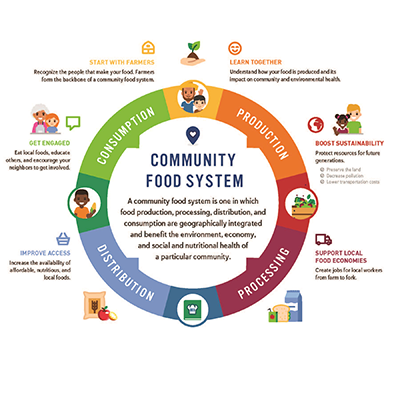

Food has become a prominent focus of US public health policy. The emphasis has been almost exclusively on what
Americans eat, not what is grown or how it is grown. A field of research, policy, and practice activities addresses the food-health-agriculture nexus, yet the work is still often considered “alternative” to the mainstream. This article outlines the diverse ways in which agriculture affects public health. It then describes three policy issues: farm-to-school programming, sustainability recommendations in the Dietary Guidelines for Americans, and antibiotic use in animal agriculture. These issues illustrate the progress, challenges, and public health benefits of taking a food systems approach that brings together the food, agriculture, and public health fields.
Food has become a prominent focus of US public health policy. Addressing concerns including food security, nutrition, diet-related disease, food safety, and environmental and occupational health effects can yield vast benefits for population health and well-being. Historically, most efforts addressing food and public health focused on food isolated from its broader context. But the public health benefits of addressing food within a food system are increasingly recognized, as can be seen from this Health Affairs issue. Food systems encompass all activities and resources that contribute to and influence producing, distributing, and consuming food, along with the drivers and outcomes of those processes. A food systems approach emphasizes the relationships between and feedback loops among these parts. (Online Appendix
One important insight deriving from a food systems approach is that agriculture—what is grown, and how and where it is grown—plays an essential role in shaping public health. This insight has shaped our careers.
Food systems approaches have at least four major benefits. First, systems approaches help shift policy attention from individual behavior to include upstream social and environmental determinants of health. Second, systems approaches can lead to fresh strategies stemming from real-world analysis inclusive of complexity, root causes, and unintended consequences. Third, systems approaches are not static. As sequential activities, feedback loops, and influences unfolding over time are captured, the effects of the food system on public health also are captured across both short- and long-term time frames. This time dimension is critical because it highlights, for example, the limitations of a strict cost-benefit approach to decision making. Costs may be more identifiable in the nearer term, while benefits are potentially much larger, less direct, and harder to quantify but no less real. Fourth, because food systems approaches embrace complexity, they encourage interdisciplinary collaboration to understand situations and formulate effective responses.
In this article we outline the ways in which agricultural activities may affect public health, and we share a brief history of activities connecting agriculture, food, and public health. We argue that although these efforts are under way and the benefits are substantial, systems approaches are still often considered “alternative” to mainstream public health considerations. We describe three current policy issues that illustrate the promise and challenges of food systems approaches and of closer partnerships among those in the food, health, and agriculture sectors.
Agriculture, Food, And Public Health
Tim Lang and Geof Rayner promote the concept of ecological public health, based on the core idea that “health depends on successful co-existence of the natural world and social relationships.” 2 Agricultural processes, even in the most technology-rich and industrialized systems, are inherently nature based. Nature’s unpredictability—for example, drought or pestilence—often accounts for the difference between crop success and failure. Within food systems, it is nature combined with agricultural decisions that may ultimately have the greatest impact on population health: What is produced and in what quantity? How is food produced, using which methods or technologies? Where?
We present an analysis that builds on the literature linking agriculture to its direct and indirect health impacts, as reviewed in depth by the Institute of Medicine (IOM) 3 and others. Exhibit 2 summarizes these essential relationships. The first column lists agricultural activities involved in producing crops and animals. Depending on how they are conducted, these activities can generate benefits and hazards to health, which are transmitted to people through pathways highlighted in the second column: food quality or quantity; community health, both direct and indirect; and labor. The third column presents examples of the wide-ranging resultant health outcomes. These could include, on the positive side, well-nourished populations and adequate food supplies; income; and the conviviality, family bonding, and pleasure that food provides.
On the negative side, agriculture can shape health outcomes from diabetes to injuries, from antibiotic resistance to asthma to food insecurity. These relationships are often not linear or unidirectional, although feedback loops are not noted in the exhibit. For example, consumer demand, driven in part by concerns about health, affects what crops farmers produce. While agriculture is the focus here, public health is also shaped by practices elsewhere in the food system, such as food processing and marketing.
To address agriculture-related health outcomes, diverse changes in agricultural practice are needed, from shifting what is produced, to producing in more sustainable ways and controlling emissions, to empowering workers. Multilayered and simultaneous policy interventions can support change. These include supporting research and development, providing positive and negative financial incentives, providing training and technical assistance, regulating agricultural practices, strengthening worker protections, and building markets for food produced in health-promoting ways. These approaches are included in federal, state, and local policies, including federal farm bills. By providing a health (and thus also economic) rationale, the public health field can play a critical role in advancing these changes in agricultural practice.
Partnerships with agriculture and other affected fields help enable public health advocates to weigh in effectively.
Linking Agriculture, Health, And Food Systems: A Brief History
While efforts to link food, agriculture, and public health have accelerated in the past decade, integrative approaches could be said to go back millennia. They were formalized in the past century within engineering. “Soft systems” approaches (incorporating human activity) have since been adopted in diverse fields, including agriculture and, increasingly, public health. 4–8 Early academic writing linking food systems and agriculture to nutrition was published in the 1970s. 9,10 By 1993 the American Dietetics Association, now the Academy of Nutrition and Dietetics, published a position paper suggesting a systems view of “the complexity of the issues associated with environmental concerns.” 11
Reflecting growing professional engagement, the American Public Health Association’s Food and Environment Working Group was established in 2006, linking hundreds of members from across the association for policy action and scientific exchange. The professional scope of practice for registered dietitian nutritionists within the Academy of Nutrition and
Dietetics now includes sustainable, resilient, and healthy food and water systems. 12 As of 2015, 550 US and Canadian hospitals and health systems have signed Health Care Without Harm’s Healthy Food in Healthcare pledge, framing as a professional responsibility the provision of food that is local, nutritious, sustainable, and produced and sold under equitable conditions.
Academic training and interdisciplinary research on food systems and public health have also flourished. Reflecting growing student demand, the first textbook on this topic was published in 2015. 14 Journals including the Journal of
Hunger and Environmental Nutrition and Public Health Nutrition also have devoted special issues to food systems and sustainability. 15–17 While food systems have garnered attention in past Health Affairs issue themes, most notably child obesity, 18 this is the first devoted to the food systems and health nexus.
On the policy front, selected approaches merging food systems, agriculture, and public health have been incorporated into major US federal policies from farm bills to reauthorizations of the Child Nutrition Act. State and local interest has led to the formation of more than 260 food policy councils in North America. 19 These councils bring together stakeholders for collective action on food system issues. Extensive work is ongoing at the international level as well.
These markers and many more suggest significant growth in policy, practice, research, and academic training based on a food systems approach. Yet this work has remained largely outside “mainstream” medical or health policy efforts. Most food-related work within the health sector remains narrowly focused at the food or food-chain level. A 2011 survey of dietetic internship directors found that although 92 percent of respondents believed that sustainable food systems belonged in dietetics training, 46 percent had no immediate plans to incorporate it because of inadequate time, resources, network contacts, institutional size, and forethought. 20 When it comes to policy, the barriers to incorporation include not only gaps in knowledge but also, in many cases, the interventions of food and agriculture industry entities guarding their financial interest in maintaining the status quo.
Roni A. Neff, Kathleen Merrigan, and David Wallinga
Healthy Celular Supplements
